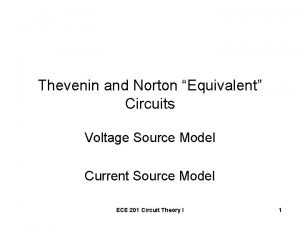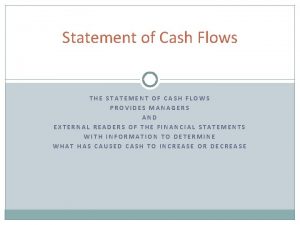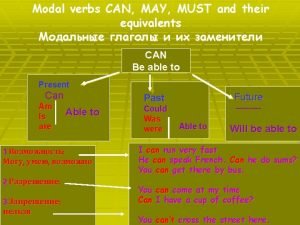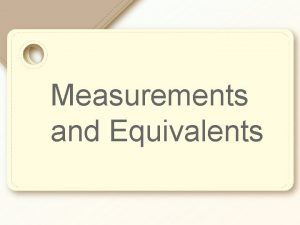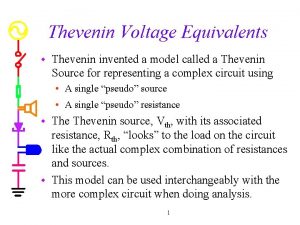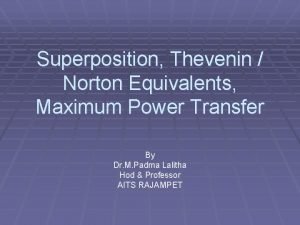Thevenin Voltage Equivalents w Thevenin invented a model














- Slides: 14

Thevenin Voltage Equivalents w Thevenin invented a model called a Thevenin Source for representing a complex circuit using • A single “pseudo” source • A single “pseudo” resistance Thevenin source, Vth, with its associated resistance, Rth, “looks” to the load on the circuit like the actual complex combination of resistances and sources. w This model can be used interchangeably with the more complex circuit when doing analysis. w 1

The Function Generator Model Recall that the function generator has an internal impedance of 50 Ohms. w Could the internal circuitry of the function generator contain only a single source and one resistor? w This is actually the Thevenin equivalent model for the circuit inside the function generator w 2

Thevenin Model Load Resistor 3

Note: w We might also see a circuit with no load resistor, like this voltage divider. 4

Thevenin Method A B w Find Vth (open circuit voltage) • Remove load if there is one so that load is open • Find voltage across the open load w Find Rth (Thevenin resistance) • Set voltage sources to zero (current sources to open) – in effect, shut off the sources • Find equivalent resistance from A to B 5

Find Vth w Remove Load A B A 6 B

Find Vth w Let Vo=12, R 1=2 k, R 2=4 k, R 3=3 k, R 4=1 k 7

Find Rth w Short out the voltage source (turn it off) & redraw the circuit for clarity. A A B B 8

Find Rth w First find the parallel combinations of R 1 & R 2 and R 3 & R 4. w Then find the series combination of the results. 9

Redraw Circuit as a Thevenin Source w Then add any load and treat it as a voltage divider. 10

Thevenin Method Tricks w Note • When a short goes across a resistor, that resistor is replaced by a short. • When a resistor connects to nothing, there will be no current through it and, thus, no voltage across it. 11

Thevenin Applet (see webpage) w 12 Test your Thevenin skills using this applet from the links for Exp 3

Does this really work? To confirm that the Thevenin method works, add a load and check the voltage across and current through the load to see that the answers agree whether the original circuit is used or its Thevenin equivalent. w If you know the Thevenin equivalent, the circuit analysis becomes much simpler. w 13

Thevenin Method Example w Checking the answer with PSpice w Note the identical voltages across the load. • 7. 4 - 3. 3 = 4. 1 (only two significant digits in Rth) 14
 Everything that can be invented has been invented
Everything that can be invented has been invented Has everything been invented
Has everything been invented High voltage technology
High voltage technology Types of ac voltage controller
Types of ac voltage controller Line current and phase current
Line current and phase current Convert from rms to peak
Convert from rms to peak Objectives of earthing
Objectives of earthing Norton
Norton Reducing equivalents
Reducing equivalents Reducing equivalents
Reducing equivalents The modal verb must
The modal verb must Cash equivalents examples
Cash equivalents examples Modal verbs and their equivalents
Modal verbs and their equivalents Measurements equivalents and adjustments
Measurements equivalents and adjustments Ssri dose equivalents chart
Ssri dose equivalents chart







